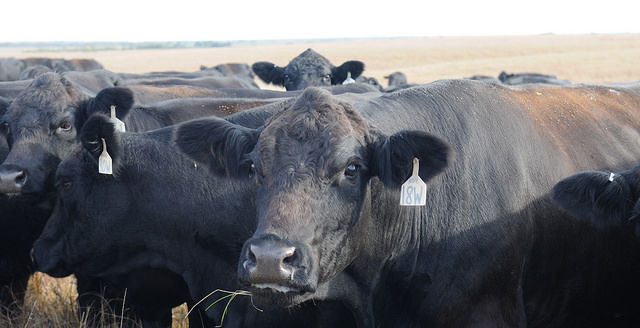Targeting problems with lice and mange can help prevent further problems in cattle herds, according to veterinarian Shawn Nicholson.
“We see the worst problems with lice and mange in the winter time when cattle are in closer contact with each other,” said Nicholson, who practices in Stuart and Anita, Iowa.
Cattle lice are a cold season insect that thrives in very cold conditions, according to University of Nebraska Extension specialist Dave Boxler. “Populations are most noticeable during December, January and February then decline during March when temperatures warm. Lice are transmitted by contact from one animal to another,” Boxler said.
Diagnosis and treatment
Signs of an external parasite problem should first be diagnosed. Hair loss, unthrifty appearance and rubbing are all signs of lice infestation though changes in temperature and additional moisture on the body can lead to itching too, so Nicholson said he wants to be sure of what he is treating. Cattle can be inspected for lice and even though the pests are very small, egg sacks can be seen easily if they are lice infested. If the problem is mange, a skin scraping can be taken and looked at under the microscope.
“Once we’ve determined the problem, then a treatment plan can be made. With the case of external parasites, we suggest treating the whole herd with a pyrethroid product,” Nicholson said. “The challenge is there is no perfect product to treat external parasites. The labels used to claim 180 days coverage and that just isn’t happening anymore.”
Nicholson recommends his clients treat their cattle more than once and about 30 days apart in order to get a lice problem under control. Often cows go through the working chute in the fall for pregnancy check and vaccinations. This is a good time to check for parasites and give an initial treatment.
Boxler said four types of lice are most common in cattle—little red chewing louse, the short-nosed cattle louse, the long-nosed cattle louse and the little blue cattle louse.
Biting or chewing little red louse are reddish brown in color with dark bands running transversally across the body. This kind of louse feed on hair, skin, skin exudates and debris near the skin surface. This species is found on the shoulder, top line and back. If populations increase they can also be found all over the animal.
“The other three are sucking lice, which feed on blood and can cause irritation, anemia, impact weight gain and even death in extreme cases,” Boxler said.
The short-nosed cattle louse is the largest at 3 to 5 millimeters in length and is typically found on older animals. This species is generally in the neck region, dewlap, back and base of the tail. Eggs normally hatch in 13 days, with a life cycle of 28 days.
The long-nosed cattle louse is about 2.5 millimeters in length, bluish in color and has a long, slender head. This louse is found on the dewlap, shoulders, sides of neck and rump. The life cycle is normally 25 days.
The little blue cattle louse is about 1 to 2 millimeters in length and bluish in color. These are usually found in dense patches on the dewlap, muzzle, neck and around the eyes. The life cycle is normally about 21 days.
Difficulties
Besides rubbing out hair, cattle with lice can suffer weight loss and possibly have problems maintaining body temperature. Nicholson said pour-ons work best on the external parasites, while injectable products work better on internal parasites.
“We don’t recommend generics in our practice because we tend to see more resistance with those products,” said Nicholson. “Our own rule has been to use a pour-on for about two years and then try something different in hopes of preventing resistance, but we heavily rely on feedback from our clients.”
Resistance to the products may be seen if the parasite biology and genetics lead to survival by fighting off the insecticide. The immune status of the host animal can lead to parasite survival, as can drug mode of action, efficacy and frequency of treatments.
Injectable insecticides tend to work better for internal parasites, according to Nicholson. Boxler said when a systemic injectable is used, it works better on the three species of sucking lice than on the little red chewing lice.
“Successful louse control depends on application timing,” said Boxler. “Many livestock producers will administer an endectocide treatment at fall weaning time, with intentions of controlling internal parasites, cattle grubs and cattle lice.”
Boxler suggested if cattle are treated in late September or October, producers should monitor their cattle for signs of lice during December, January and February. If new animals are brought into a herd in the winter months, Nicholson and Boxler both said the cattle should be isolated and treated before introduction into the existing herd.
“Overall surveillance and proper management of the herd can prevent many problems with parasites,” Nicholson said. “Prevention and quick treatment will also help keep the resistance problem at a minimum.”
Jennifer Carrico can be reached at 515-833-2120 or [email protected].



